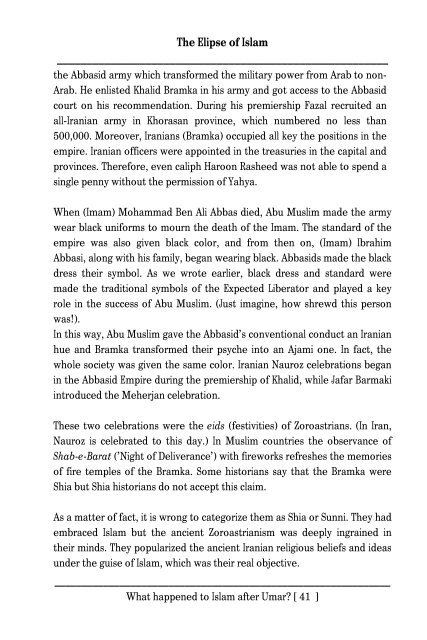The-Eclipse-of-Islam-What-happend-to-Islam-after-Umar-by-G-A-Parwez-Tolue-Islam-Trust
The-Eclipse-of-Islam-What-happend-to-Islam-after-Umar-by-G-A-Parwez-Tolue-Islam-Trust
The-Eclipse-of-Islam-What-happend-to-Islam-after-Umar-by-G-A-Parwez-Tolue-Islam-Trust
You also want an ePaper? Increase the reach of your titles
YUMPU automatically turns print PDFs into web optimized ePapers that Google loves.
<strong>The</strong> Elipse <strong>of</strong> <strong>Islam</strong>________________________________________________________the Abbasid army which transformed the military power from Arab <strong>to</strong> non-Arab. He enlisted Khalid Bramka in his army and got access <strong>to</strong> the Abbasidcourt on his recommendation. During his premiership Fazal recruited anall-Iranian army in Khorasan province, which numbered no less than500,000. Moreover, Iranians (Bramka) occupied all key the positions in theempire. Iranian <strong>of</strong>ficers were appointed in the treasuries in the capital andprovinces. <strong>The</strong>refore, even caliph Haroon Rasheed was not able <strong>to</strong> spend asingle penny without the permission <strong>of</strong> Yahya.When (Imam) Mohammad Ben Ali Abbas died, Abu Muslim made the armywear black uniforms <strong>to</strong> mourn the death <strong>of</strong> the Imam. <strong>The</strong> standard <strong>of</strong> theempire was also given black color, and from then on, (Imam) IbrahimAbbasi, along with his family, began wearing black. Abbasids made the blackdress their symbol. As we wrote earlier, black dress and standard weremade the traditional symbols <strong>of</strong> the Expected Libera<strong>to</strong>r and played a keyrole in the success <strong>of</strong> Abu Muslim. (Just imagine, how shrewd this personwas!).In this way, Abu Muslim gave the Abbasid’s conventional conduct an Iranianhue and Bramka transformed their psyche in<strong>to</strong> an Ajami one. In fact, thewhole society was given the same color. Iranian Nauroz celebrations beganin the Abbasid Empire during the premiership <strong>of</strong> Khalid, while Jafar Barmakiintroduced the Meherjan celebration.<strong>The</strong>se two celebrations were the eids (festivities) <strong>of</strong> Zoroastrians. (In Iran,Nauroz is celebrated <strong>to</strong> this day.) In Muslim countries the observance <strong>of</strong>Shab-e-Barat (’Night <strong>of</strong> Deliverance’) with fireworks refreshes the memories<strong>of</strong> fire temples <strong>of</strong> the Bramka. Some his<strong>to</strong>rians say that the Bramka wereShia but Shia his<strong>to</strong>rians do not accept this claim.As a matter <strong>of</strong> fact, it is wrong <strong>to</strong> categorize them as Shia or Sunni. <strong>The</strong>y hadembraced <strong>Islam</strong> but the ancient Zoroastrianism was deeply ingrained intheir minds. <strong>The</strong>y popularized the ancient Iranian religious beliefs and ideasunder the guise <strong>of</strong> <strong>Islam</strong>, which was their real objective.______________________________________________________________<strong>What</strong> happened <strong>to</strong> <strong>Islam</strong> <strong>after</strong> <strong>Umar</strong>? [ 41 ]


